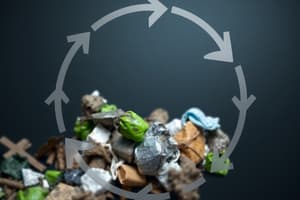Podcast
Questions and Answers
What does the term 'waste' refer to?
What does the term 'waste' refer to?
- Left-over products that are unwanted by the owner (correct)
- Products that are always discarded without consideration
- Materials that can always be recycled
- A valuable resource for the owner
Which factor does NOT influence what is considered waste?
Which factor does NOT influence what is considered waste?
- Socio-economic conditions
- Personal opinion of friends (correct)
- Time and context
- Location, such as urban versus rural areas
What is the traditional approach to waste?
What is the traditional approach to waste?
- Minimize the generation of waste entirely
- Transform waste into new products
- Focus on resource recovery and recycling
- Extract materials, use them, and dispose of waste (correct)
In a circular economy, what is emphasized compared to the traditional approach?
In a circular economy, what is emphasized compared to the traditional approach?
What is municipal solid waste primarily generated from?
What is municipal solid waste primarily generated from?
What type of waste is often generated from single-use products?
What type of waste is often generated from single-use products?
Which factor contributes to consumer obsolescence?
Which factor contributes to consumer obsolescence?
What percentage of waste goes to landfill, according to the information on waste disposal?
What percentage of waste goes to landfill, according to the information on waste disposal?
What type of air pollutant is primarily composed of carbon dioxide?
What type of air pollutant is primarily composed of carbon dioxide?
Which of the following contributes to air pollution as a primary pollutant?
Which of the following contributes to air pollution as a primary pollutant?
What is one environmental impact of plastic waste?
What is one environmental impact of plastic waste?
What process allows air pollutants to disperse over a larger area?
What process allows air pollutants to disperse over a larger area?
What percentage of air pollutants are released through secondary chemical reactions?
What percentage of air pollutants are released through secondary chemical reactions?
What is a significant challenge with microplastics in the ocean?
What is a significant challenge with microplastics in the ocean?
What is the average timeframe a typical consumer keeps their smartphone?
What is the average timeframe a typical consumer keeps their smartphone?
What feature of products contributes to planned obsolescence?
What feature of products contributes to planned obsolescence?
What major phenomenon do industrial activities lead to concerning air pollutants?
What major phenomenon do industrial activities lead to concerning air pollutants?
How do wind patterns affect the behavior of air pollutants?
How do wind patterns affect the behavior of air pollutants?
What company aims to reduce its plastic waste by reusing materials to make new bottles?
What company aims to reduce its plastic waste by reusing materials to make new bottles?
Flashcards
Waste definition
Waste definition
Leftover, redundant products or materials of little value to the owner, which they want to discard.
Waste factors
Waste factors
Waste depends on time, location, economics, and resources available for disposal.
Traditional waste
Traditional waste
Using resources, creating waste, and discarding it with little recycling.
Circular economy
Circular economy
Signup and view all the flashcards
Municipal solid waste
Municipal solid waste
Signup and view all the flashcards
Single-use products
Single-use products
Signup and view all the flashcards
Planned Obsolescence
Planned Obsolescence
Signup and view all the flashcards
Consumer Obsolescence
Consumer Obsolescence
Signup and view all the flashcards
Waste disposal issues
Waste disposal issues
Signup and view all the flashcards
E-waste recovery
E-waste recovery
Signup and view all the flashcards
Air pollutants
Air pollutants
Signup and view all the flashcards
Primary air pollutants
Primary air pollutants
Signup and view all the flashcards
Secondary air pollutants
Secondary air pollutants
Signup and view all the flashcards
Photochemical smog
Photochemical smog
Signup and view all the flashcards
Airflow patterns
Airflow patterns
Signup and view all the flashcards
Inversion layer
Inversion layer
Signup and view all the flashcards
Microplastics
Microplastics
Signup and view all the flashcards
Environmental impacts of plastic waste
Environmental impacts of plastic waste
Signup and view all the flashcards
Study Notes
Waste Definition and Types
- Waste is leftover, redundant items/materials of little or no value to the owner, intended for disposal.
- Factors influencing waste categorisation include time, context, recycling potential, location (urban/rural access to disposal), socio-economic conditions (affordability), and resource availability.
- What constitutes waste is subjective; one person's trash can be another's treasure.
Traditional vs. Circular Economy Approach
- Traditional approach: Extract, use, dispose (resulting in minimal recycling).
- Circular economy approach: Aims to eliminate virgin raw materials, prioritize resource recovery, reduce raw material use, and increase resource recovery.
Waste Management Overview
- Municipal solid waste encompasses household, commercial, and institutional waste.
- High per capita waste generation observed in wealthier countries.
- Key issues include:
- Single-use products: Often discarded carelessly, contributing significantly to waste streams (e.g., sachet packaging, food wrappers).
- Planned obsolescence: Items designed for frequent replacement (e.g., electronics, clothes) rather than durability. This happens in three ways: Companies design products for shorter lifespans; products are made difficult to fix or maintain; and consumer trends promote the replacement of items.
- Consumer obsolescence: Technological advancements lead to rapid replacement of items.
Waste Disposal Methods and Environmental Impacts
- Landfill (30%): While a current disposal method, contributes to pollutants.
- Open dumping (33%): Common in developing countries, significant problem, especially with third-world countries doing open dumping and burning (93% of waste). Generation of toxic pollutants.
- Recyclable waste resources: Significant value in waste products, potentially recovering raw materials.
- E-waste: Huge potential raw material resource, yet often discarded improperly.
Air Pollution Overview
- Types of pollutants:
- Trace gases: (e.g., methane, hydrogen), very low concentrations within the atmosphere.
- Volatile organic compounds (VOCs): Carbon-containing substances that evaporate easily. Both human and natural sources (e.g., flowers, paint).
- Particulate matter (PM): Solid or liquid particles in the air. PM2.5 (smaller) and PM10 (larger) particles are hazardous, inhalable, and result in respiratory issues.
- Persistent organic pollutants (POPs): Pollutants that persist and accumulate in the environment (and food chains).
- Heavy metals: Released from industrial processes that can have significant health impacts. Often are both air and soil pollutants.
- Types of pollutant origins:
- Primary pollutants: Released directly into the atmosphere.
- Secondary pollutants: Formed through reactions in the air.
- Photochemical pollutants: Formed through sun-catalyzed reaction in the atmosphere
- Air pollution transport: Air patterns, diffusion, and wind patterns affect the distribution of pollutants.
- Inversion layer: An atmospheric layer where air pollutants accumulate due to less dispersed air. Higher emission height generally results in further transport of pollution.
- Atmospheric lifetime: The time a pollutant remains in the atmosphere and can result in an overall impact.
Connecting Waste to Environmental Impacts
- Widespread plastic waste, including microplastics, is affecting marine ecosystems and food chains.
- Increased plastic usage has altered ecosystems in negative ways.
- Excessive waste disposal is a major environmental concern.
Responses to Waste Problems
- Individual and collective actions: Plastic purges and community initiatives.
- Technological solutions: Research on compostable and plastic-eating bacteria.
- Corporate initiatives: Companies (e.g., Unilever, Coca-Cola) exploring reuse and reduction strategies.
- Waste diversion: Converting and repurposing waste materials into viable resources.
Studying That Suits You
Use AI to generate personalized quizzes and flashcards to suit your learning preferences.




